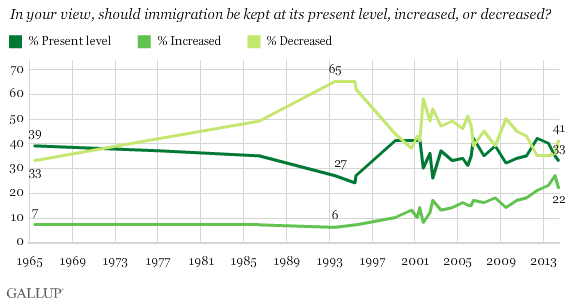
by Robert VerBruggen
Immigration will mean death for the Republican Party as left-leaning Hispanics increase in number, team up with white liberals and overwhelmingly Democratic blacks, and turn the electoral map blue. It’s only by embracing the trend that threatens them — by supporting comprehensive immigration reform — that Republicans can win over Hispanics and save themselves.
That’s the story, anyway. But it neglects several important things, one of which is the remaining electoral power of whites, who will stay a majority for decades and in an underappreciated trend have been leaving the Democrats over the last half-century. White Backlash, a new book from political scientists Marisa Abrajano and Zoltan L. Hajnal, says that immigration may actually contribute to this last phenomenon, driving whites unhappy with current policy to the right.
The authors show that immigration is important to many white voters, and they provide fascinating evidence suggesting that it may drive larger trends to some degree. But the elaborate statistics presented here are in tension with some simpler facts about partisanship and public opinion, and the authors’ discussion of the policy and political ramifications is unsatisfying.
It’s hardly surprising that immigration restrictionists tend to be Republicans. But Abrajano and Hajnal go beyond that, demonstrating with complex analyses — many of them performed in multiple ways and on data from multiple sources — a variety of more telling correlations. For instance, views on immigration predict voting behavior even after other factors, including party affiliation, ideology, and other policy preferences, have been taken into account. Immigration-skeptical whites are more likely to shift their party identification to the right in the future. When the white population as a whole reports a less favorable view of immigration, it too is more likely to shift toward GOP party identification later.
Geographic patterns are helpful as well: With other variables held constant, whites who live in states with high Hispanic populations are more likely to see immigration as a problem, more likely to identify as conservative or Republican, and more likely to take conservative policy positions. States with higher Hispanic populations spend more on corrections, spend less on education, and are more likely to prefer regressive taxes, at least up to the point that the Hispanic population gets big enough to wield its own political power.
The natural conclusion from all this is that a rising Hispanic population might help explain whites’ shift to the GOP. But social-science claims, especially those relating to Republicans and race, always deserve to be taken with a grain of salt. The authors are the first to admit that many of the relationships they’ve identified are relatively weak — and it helps to bear two basic facts in mind as one considers the argument here. Abrajano and Hajnal don’t conceal or deny these facts, but it’s easy to lose sight of them in the midst of so much intense, fine-grained number crunching.
First, while the Hispanic share of the U.S. population has steadily increased since 1980 — starting at 6 percent and nearly tripling — whites’ shift toward the GOP has been a more complicated, intermittent, and slow process during this period. Here, for example, is a chart the authors provide on white party identification. They present it as a steady rightward march, but it’s just as easy to see it as a huge transformation that ended in the mid-’80s, followed by some ups and downs for both parties.
Also helpful are numbers from Pew that run from 1992 through 2014, which show a nine-point gap today in white party identification — but also reveal that Democrats have closed similar gaps twice in the past two decades. The parties were essentially tied among whites as recently as 2009, and also a decade before that:
White Backlash provides a few other measures, too, which are similarly murky. In congressional elections, whites lurched to the right with the 1994 Republican Revolution and stayed there, but — despite a record GOP high for whites in 2010, the year of the Tea Party — it’s hard to see a consistent trend since then. White Senate voting has steadily drifted rightward, though slowly: 47.2 percent in the ’70s, 50.8 percent in the ’80s, 51.9 percent in the ’90s, 53.7 percent in the ’00s.
The other key fact is that, while there’s plenty of opposition to mass immigration — even Hispanics are more likely to support decreasing immigration than to support increasing it — immigration has actually grown in popularity along with the Hispanic population over the last 20 years. Here’s data from Gallup showing trends for the U.S. population as a whole; the trends for non-Hispanic whites have been basically the same since 2001, the first year for which I can find data for them specifically:
Crucially, this poll question (from 1993 to 2011) is one the authors use to show that whites’ attitudes toward immigration are correlated with subsequent shifts in their overall partisanship. It’s troubling that the broad trend is in the wrong direction, with whites becoming more pro-immigration in the midst of an alleged backlash.
This isn’t to say the authors are wrong. Even as whites in general have become more supportive of immigration, whites who do want to reduce immigration — usually more than 40 percent — have no doubt become more passionate about it as the issue has become more salient. There are different patterns in different parts of the country, too; numerous high-immigration states have passed laws specifically designed to address the issue, for example. But it’s hard to get excited about a backlash that doesn’t even show up in the most basic polling data.
 Nonetheless, it’s worth delving into the nuances of the white reaction. The authors aren’t able to suss out exactly what bothers some whites about Hispanic immigration — these immigrants disproportionately come illegally, are disproportionately poor and low-skilled, and are, well, Hispanic. All of this seems to be jumbled together in many whites’ minds. But it is clear that the reaction is to Hispanics, not to immigrants or nonwhites in general; Abrajano and Hajnal find their results disappear, and sometimes even reverse, when they look at Asians instead.
Nonetheless, it’s worth delving into the nuances of the white reaction. The authors aren’t able to suss out exactly what bothers some whites about Hispanic immigration — these immigrants disproportionately come illegally, are disproportionately poor and low-skilled, and are, well, Hispanic. All of this seems to be jumbled together in many whites’ minds. But it is clear that the reaction is to Hispanics, not to immigrants or nonwhites in general; Abrajano and Hajnal find their results disappear, and sometimes even reverse, when they look at Asians instead.
Is there any legitimacy at all to whites’ concerns? It’s a key question, and the answer should shape both policy and politics. If this is rank prejudice, policymakers owe it no deference — if anything, they should seek to combat it — and the GOP should be ashamed of profiting from it.
Indeed, the authors assure us that Hispanics are assimilating just as well as previous waves of immigrants did, and that immigration benefits almost all natives economically, suggesting that any fears are stoked by negative media portrayals. But they hint at some troubling issues as well: For example, Hispanics make less money than whites (as opposed to Asians, who make more) and have higher incarceration rates. A deeper exploration of these problems, and a more balanced presentation of the debates surrounding them, would have improved the book.
There are, in fact, many causes for concern about mass low-skill immigration, which in practice comes largely from Latin America. There is evidence that Hispanic educational assimilation stops after the second generation. There’s also a deeper trend behind Hispanic incarceration rates that complicates the authors’ narrative: Like all immigrants, Hispanic immigrants rarely end up behind bars; it’s native-born Hispanics whose incarceration far outpaces that of whites. (Perhaps some of this can be chalked up to racism in the criminal-justice system, but young Hispanic males are also much more likely than their whites peers to show up at the ER with gunshot wounds.) And of course there are the neverending debates over whether low-skill immigration drives down wages for low-skill natives, how much pressure illegal and low-skill immigrants put on public services, and so on and so forth.
These concerns may or may not tip the scales against any given immigration proposal, and they may or may not be a good reason to vote for Republicans instead of Democrats. But they can’t simply be tossed aside as racist. In other words, the authors haven’t necessarily found a core of bigotry that magically turns white people into Republicans when Hispanics move into their general vicinity. They may have simply revealed a natural and understandable — if sometimes crudely expressed — response to real problems that result from government immigration policy.
And that brings us to what this means for the Republican Party. In a late chapter, Abrajano and Hajnal admit the obvious: According to their own research, Republicans may gain substantial white support by being the party that opposes Hispanic immigration. However, they argue that this will change over the long term as whites slip into the minority and Hispanics gain power of their own. The authors then trot out the conventional wisdom that Republicans would be wise to endorse immigration reform to win over Hispanics.
This is a very difficult math problem, one that the authors make progress on but don’t quite solve. Immigration reform is popular with Hispanics, and endorsing it may well increase the GOP share of the Hispanic vote, which today tends to be around 30 percent. On the other hand, White Backlash shows the consequences this could have for the white vote —even if the book’s case is overstated, white immigration skeptics do give a lot of support to the party, and many may stay home or vote Democrat if Republicans change their stance.
And what the authors don’t delve into is the effect of immigration reform itself: If Republicans pass it instead of stopping it, Hispanics’ political power will likely increase (depending on the specifics of the legislation) as some become citizens and others move to America. Unless Hispanics are so grateful that at least 50 percent of them start voting Republican —which is highly unlikely given that Hispanics’ liberalism isn’t limited to immigration — this will cost the GOP votes. With today’s roughly 70-30 partisan split, for example, every 100 new Hispanic voters are the electoral equivalent of adding 40 Democratic votes and zero Republican ones. Cut the gap in half, as Bush famously did in 2004, and that’s still 20 votes per 100 voters.
The CBO estimated that a recent immigration-reform bill would grant legal status to 8 million people who are already here and increase the U.S. population by 10.4 million in a single decade, so the potential for a skewed impact on voting, especially in high-immigration states and over the long run, is huge. Add in the white support that immigration reform could cost Republicans, and it’s still an open question whether, or when, this will be a politically smart move. There also may be, as RCP’s Sean Trende has suggested, a middle ground for Republicans: They could avoid offending Hispanics without fully endorsing immigration reform, and win elections going forward with around a 35 percent share of the Hispanic vote.
White Backlash, despite any flaws, is an important contribution to the debate over immigration and the tensions it stokes. It deserves careful attention — and criticism — as America decides what path to take going forward.
Robert VerBruggen is editor of RealClearPolicy at RealClearPolitics






